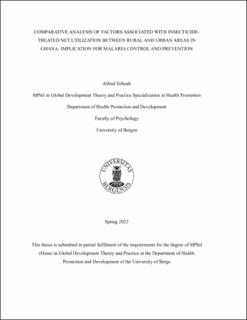Comparative analysis of factors associated with insecticide-treated net utilization between rural and urban areas in Ghana: implication for malaria control and prevention
Master thesis
Permanent lenke
https://hdl.handle.net/11250/3070427Utgivelsesdato
2023-05-15Metadata
Vis full innførselSamlinger
- Master theses [157]
Sammendrag
Malaria is a global health and development challenge, so the World Health Organization (WHO) has recommended the use of Insecticide-Treated Nets (ITNs) for its prevention. In Ghana, despite efforts to increase ITN ownership, ITN utilization among urban residents is still low, creating a wide disparity between rural and urban residents in Ghana. Therefore, this study aimed to investigate factors that influence ITN use in rural and urban contexts in Ghana. The study was a cross-sectional design and used data from the 2019 Ghana Malaria Indicator Survey (GMIS). A representative sample of 25,316 households across various regions of Ghana was selected using a multistage cluster sampling technique. Descriptive statistics were initially conducted to determine the characteristics of the data. Bivariate analysis, specifically a chi-square test of association, was conducted to examine the association between residence and ITN use. Separate bivariate analyses were conducted to determine factors associated with ITN use in each residence type. A hierarchical multiple binary logistic regression was further conducted to determine factors associated with ITN use. The key findings of the study showed a significant association between residence and ITN utilization [χ2 (1, N = 25284) = 1373.78, p < 0.001]. Rural residents were more likely to use ITNs than urban residents. Also, the study revealed that the education level of household heads is significantly associated with ITN use in both rural and urban areas. Additionally, the study demonstrated that in both rural and urban areas, households in the second, middle, fourth and richest wealth quintiles are likely to use ITNs. Interestingly, the results of the study showed that households without a child under five were significantly more likely to use ITNs in urban areas. Based on these findings, the study stressed the need for targeted interventions to improve ITN utilization among urban residents in Ghana and emphasized the importance of education and wealth status in shaping ITN use. Overall, these findings highlight the complex interplay of social, economic and demographic factors that influence ITN utilization in Ghana. They underscore the need for multifaceted approaches that take into account the specific needs and challenges faced by different populations in both rural and urban settings, as espoused by McLeroy et al.'s (1988) social ecological model of health promotion
